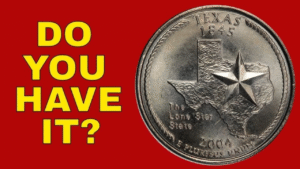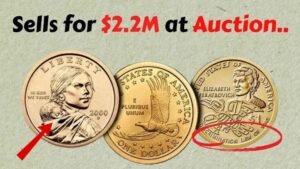Your Coins Be Worth Millions: Imagine finding a coin in your change worth millions! Coin collectors are always hunting for rare coins with unique errors, low mintages, or historical value. Some, like the 1943 Copper Penny or the 1794 Flowing Hair Dollar, can fetch jaw-dropping prices at auctions. This article lists the top 10 rare coins collectors crave in 2025, explains in simple words how to spot them, and shares tips on where to look. Check your coins—you might have a treasure!
What Makes a Coin Rare and Valuable?
Collectors pay big money for coins that are hard to find or have special features. Key factors include:
- Low Mintage: Fewer coins made means they’re rarer.
- Errors: Mistakes like wrong metals or double stamping.
- Condition: Shiny, unworn coins are worth more.
- History: Coins tied to important events or people are prized.
Some coins, like those from wartime or the early U.S., are especially sought after.
Top 10 Rare Coins Collectors Want
Here are the top 10 coins collectors are chasing in 2025, based on rarity and value:
1. 1943 Copper Lincoln Penny
- Why Rare: Struck in copper instead of steel during WWII, only about 20 exist.
- How to Spot: Copper color, weighs 3.11 grams, doesn’t stick to a magnet.
- Value: $200,000–$1.7 million.
2. 1794 Flowing Hair Silver Dollar
- Why Rare: First U.S. silver dollar, with only 120–130 left.
- How to Spot: “1794” date, Lady Liberty with flowing hair, eagle on back.
- Value: $7.75 million–$10 million.
3. 1933 Saint-Gaudens Double Eagle
- Why Rare: Most were melted after gold was recalled in 1933, only 13 survive.
- How to Spot: “1933” date, Lady Liberty with torch, gold coin.
- Value: $7.59 million–$18.9 million.
4. 1913 Liberty Head Nickel
- Why Rare: Only five made, possibly unauthorized by the Mint.
- How to Spot: “1913” date, Lady Liberty, no official Mint records.
- Value: $4.75 million.
5. 1969-S Lincoln Cent Double-Die Obverse
- Why Rare: Blurry text from double stamping, fewer than 100 known.
- How to Spot: Doubled “LIBERTY” or “1969” with a magnifying glass.
- Value: $24,000–$126,500.
6. 1893-S Morgan Silver Dollar
- Why Rare: Low mintage of 100,000, many worn or lost.
- How to Spot: “1893” date, “S” mint mark, Lady Liberty, silver.
- Value: $100,000–$2 million.
7. 1916-D Mercury Dime
- Why Rare: Low mintage of 264,000, often worn.
- How to Spot: “1916” date, “D” mint mark, Winged Liberty head.
- Value: $10,000–$1 million.
8. 1909-S VDB Lincoln Penny
- Why Rare: Only 484,000 made with designer’s initials.
- How to Spot: “1909” date, “S” mint mark, “VDB” on back.
- Value: $700–$100,000.
9. 1870-S Three-Dollar Gold Piece
- Why Rare: Only a few survive, possibly experimental.
- How to Spot: “1870” date, “S” mint mark, Liberty with crown, gold.
- Value: $80,000–$1 million.
10. 1927-D Saint-Gaudens Double Eagle
- Why Rare: Most of 180,000 minted were melted in 1933.
- How to Spot: “1927” date, “D” mint mark, Lady Liberty, gold.
- Value: $1 million–$7 million.
| Coin Type | Key Feature | Mint Mark | Estimated Value |
|---|---|---|---|
| 1943 Copper Penny | Copper, not steel | None, D, S | $200,000–$1.7M |
| 1794 Flowing Hair Dollar | First U.S. silver dollar | None | $7.75M–$10M |
| 1933 Double Eagle | Most melted, gold coin | None | $7.59M–$18.9M |
| 1913 Liberty Head Nickel | Only five made | None | $4.75M |
| 1969-S Double-Die Penny | Blurry text | S | $24,000–$126,500 |
| 1893-S Morgan Dollar | Low mintage, silver | S | $100,000–$2M |
| 1916-D Mercury Dime | Low mintage | D | $10,000–$1M |
| 1909-S VDB Penny | Designer’s initials | S | $700–$100,000 |
| 1870-S Three-Dollar Gold | Few survive, gold | S | $80,000–$1M |
| 1927-D Double Eagle | Most melted, gold | D | $1M–$7M |
How to Spot a Valuable Coin
To find a rare coin:
- Check Dates and Mint Marks: Look for specific years and marks like “D” or “S.”
- Inspect for Errors: Use a magnifying glass for doubled text or wrong metals.
- Test Materials: For 1943 pennies, copper doesn’t stick to a magnet; for gold or silver, check weight (e.g., silver dollars weigh ~26.73 grams).
- Check Condition: Unworn, shiny coins are worth more.
Where to Find These Coins
You might find them in:
- Pocket Change: Some coins, like pennies or dimes, still circulate.
- Coin Rolls: Get rolls from banks to search.
- Old Collections: Check family jars, piggy banks, or inherited coins.
- Coin Shops or Auctions: Visit dealers or check eBay, Heritage Auctions, or GreatCollections.
What to Do If You Find One
- Don’t Clean It: Cleaning can scratch or dull coins, lowering value.
- Store Safely: Use plastic coin holders to protect them.
- Get It Graded: Take to PCGS or NGC for authentication and grading.
- Sell Smart: Use auction houses (Heritage Auctions), dealers (APMEX), or eBay with clear photos.
Avoiding Fakes
Fakes are common, especially for high-value coins. To avoid scams:
- Verify Materials: Test with a magnet or weigh the coin (e.g., 1943 copper penny: 3.11 grams).
- Check Details: Look for tampering on dates or mint marks.
- Trust Grading Services: Only PCGS or NGC can confirm authenticity.
Conclusion
Rare coins like the 1943 Copper Penny or 1794 Flowing Hair Dollar could be hiding in your change, coin rolls, or old jars, potentially worth millions in 2025. Check for key dates, mint marks, errors, and pristine condition, and get finds graded by experts. Beware of fakes and handle coins carefully. The thrill of finding a valuable coin makes every search exciting. Start checking your coins today—you might uncover a fortune!
FAQ
Are these rare coins really worth millions?
Yes, coins like the 1933 Double Eagle sold for $18.9 million, and others can reach millions depending on condition and rarity.
Which coins are the most valuable in 2025?
The 1943 Copper Penny, 1794 Flowing Hair Dollar, and 1933 Double Eagle top the list for collectors.
Can I find these coins in circulation?
Some, like pennies or dimes, might appear in change or bank rolls, but high-value coins are usually in collections or auctions.
How do I spot a rare coin?
Check dates, mint marks (D, S), errors like doubled text, or materials (e.g., copper for 1943 pennies doesn’t stick to magnets).
What should I do if I find a rare coin?
Don’t clean it, store it in a coin holder, get it graded by PCGS or NGC, and sell via auctions or trusted dealers.



